![]()
Notes on some of those included in the Dedham pedigree.
The pedigree begins with Robert Tyler alias Alfunder of Long Melford in Suffolk, known to me and connected to the family tree only from his will. Neither probate records nor the Long Melford parish registers have taken the family back any further, although other parish records show Alefounders living there in the 1540s (Parker, 1873; Dymond & Paine, 1992). There are two other wills probably written by relatives, those of James Alefownder alias Tyler (1576) and Rychard Tyler alias Aleyfounder (1587). Professor Alan H. Nelson, of the University of California, Berkeley, has prepared a transcript of a Chancery case (1585) involving Richard Tyler alias Allfounder (who claimed to be about 90 years old). A certain Richard Alefounder alias Tyler is mentioned in the records of Old Hall, East Bergholt (1610).
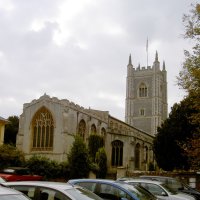
St Mary's, Dedham
Larger version of picture (437KB).
It is this gentleman who appears at the head of the two Alfounder pedigrees given in the 1664 heraldic visitation of Essex (Bysshe, 1664), and the one in Nichols' History of Leicestershire. Robert Alefounder was a clothier, which is to say, a wholesale dealer in woolen cloth. He appears to have become quite wealthy. Morant (1768) in his History of Essex gives some details of his estate:
[p 483, concerning Kirkby]
The Manor of Grove-house
Robert Alefounder of Dedham was possessed at the time of his decease 5 April 1630 of this whole maner or capital messuage of Grove-house; and of a messuage called Faytes, and 126 acres of land therwith occupied, in Kirkeby; holden of this maner, in socage, by fealty, and rent of 18s 2d. - Robert his son and successor was then 40 years old (a)
(a) Inquis. 6 Caro. Aug 19
[p 486, concerning Bernhams]
Robert Alefounder of Dedham who departed this life 5 April 1630, held the maner of Barnhams, and 120 acres of land therto belonging, in Beamont, Weeley, Tendring and Thorpe, of Earl Rivers, as of his maner of Old-hall and New-hall in Beamont, in free socage, by fealty, and 4s rent. - Robert was his son and heir (a) see under Kirby. This estate as far as we can find, is incorporated into the other.
(a) Inquis. 6 Caro. Aug 19
He also held land in East Bergholt, and lived there for a while before 1600, as is apparent from a Certificate of Residence issued in that year.
In his will, he split his fortune between his two sons then alive, Robert (ca. 1589-1639) receiving land in Kirby and Walton while John (ca. 1609-1673) had land in Dedham, Beaumont, Tendring and Thorpe. His wife, daughters and various others were left money. They mounted a challenge to the will, against Robert and John, but did not appear in court and lost the case. However, this was not the end of disputes arising from this will. Following the death of Robert the son in 1639, John complained to the Court of Chancery that Robert's children were troubling him for money they said had been due to their father (TNA ref. C2/ChasI/A10/2, dated 28 Jan 1639). In a cross bill of 17 Feb 1639 (C2/ChasI/A32/20), Robert in turn complained that John had not paid money owing under his grandfather's will. The sisters Anne and Elizabeth, together with her husband John Trenham, supported Robert in an answer to John's bill. John maintained that after his father's death, he and his brother Robert had met at the house of the deceased and resided there for a few days until the personal effects had been inventoried and valued. They had then agreed upon the distribution. Robert's children said that they did not believe this agreement had taken place, as Robert had during his life time complained about the matter. It appears that the dispute was settled out of court.
Son of the above, and also a wealthy gentleman, owning land in Walton, Kirby, East Bergholt and Winson. In his will, he left all his land to his elder son Robert, with the exception of one farm bequeathed to his younger son, John. There were bequests of money to his daughters and other relatives. His wife was to receive £60 per year from the land left to Robert, a substantial income in those days. It is clear that the main intention was to keep the family fortune intact; John, understandably not appreciating this, mounted a legal challenge to the will, which he lost.
On his death, Robert Alefounder was accorded the relatively rare honour of a church brass.
Another son of Robert (ca. 1551-1630). Held land in Dedham and made regular appearances among the Homage of the manor of Dedham Hall. In his will, he left land to his sons Robert and Matthew. Some land which he directed to be sold to pay debts and lagacies was purchased by Robert for £105 (Dedham Hall court books, 1673). Matthew also inherited some land by custom of the manor, he being the youngest son. The family appears to have lost touch with another son, John: the will suggests that he was not even known to be still living.
Southfields, Dedham
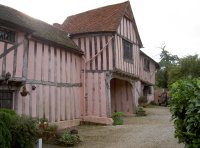
Entrance, on the north side
Larger version of picture (227KB).
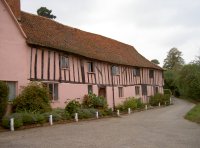
East side
Larger version of picture (225KB).
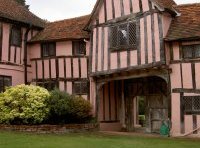
Courtyard, showing the north-west corner
Larger version of picture (278KB).
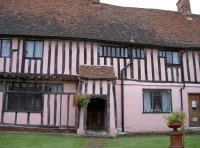
Inside the courtyard, facing west
Larger version of picture (269KB).
Daughter of Robert (ca.1551-1630). Married Henry Fenne. From his father, Symon, he inherited Southfields, a large house built around a rectangular courtyard. The house has since been split into a number of separate apartments, but is still identifiable today (pictures at right).
Anne Alefounder formerly Howe, née Woodgate, appears in the Woodgate pedigree given by Muskett (1900b) in his Suffolk Manorial Families. According to this, her father, Stephen Woodgate of East Bergholt, clothier, d. 1598, was the son of Stephen Woodgate of East Bergholt, clothier, d. 1557 and Cecily. Her mother, Stephen's first wife, is said to be Katherine, widow of John Whyter, daughter of William Hovell als Smith of Haughley, gentleman (his will proved 1582).
John Alefounder, like many in this family, was a clothier. His will reflects this, and also gives some indication of the extent of his business interests: a share in a ship called the Good Intent.
Susan Alefounder née Holloway is mentioned in the Goodwin pedigree in Suffolk Manorial Families (Muskett 1900a), her father being William Holloway of East Bergholt, clothier (will proved 1608) who was the 2nd husband (of 3) of Elizabeth daughter of Robert Lincoln als Skinner (will proved 1590). Muskett (1900a) says she was the sister of Daniel Skinner of East Bergholt (will proved 1608) – I believe Samuel Skinner is meant.
Admitted to Emmanuel College, Cambridge, 8 March 1648/9, as a pensioner (the second of the three ranks of undergraduate); matriculated in 1649, gained degrees of BA in 1652/3, MA 1656 and BD in 1663. He became a fellow of the college in 1655, then served as Rector of Thurcaston, Leicestershire, from 1668 until his death on 12 March 1700/1. According to Venn & Venn, he was awarded the degree of DD in 1683, although this is not mentioned on his gravestone.
The archives of the University of Cambridge (Mm.1.45 p132-3) contain copies of some letters from Robert Alfounder from his time as a Fellow of Emmanuel College. The first, dated 4 April 1665, to the Revd: & Worthy Dr Sancroft Dean of St Paul's, concerns a complaint from the College about the proposed appointment of a certain William Wickins as a Fellow, he being of "indifferent learning". It seems he obtained a testimonial from the College on the pretext of going to "live with some Gentleman as Chaplain". This he used to support a request from the Earl of Manchester for a Royal Mandat for the Fellowship. The testimonial was "of the lowest forme", but "in the Royall letter is called a ample Testimony". The outcome of this request to have the letter revoked or altered is not given.
Further letters concern the acquisition of Dr Holdsworth's library, a new Chapel for the College, and the resignation of Dr Sancroft and his replacement.
During his time as a fellow at Emmanuel College, Edward Bright, a former tutor of his (and by then the incumbent at Mary Woolnoth, Lombard Street, London), died. Some elegies that Robert Alfounder wrote for the funeral service have been preserved in Samuel Jacombe's "Moses his Death" (1657). He is thus the first holder of the surname (that I know of) to have any of his work published.
In 1668 Robert Alfounder became Rector of Thurcaston in Leicestershire. He appeared at the Dedham Hall manorial court in 1673 to claim land left to him by his father John and made an additional purchase of some of his father's land as well. All this land he used as security for a loan from Mary Mason in 1674. It appears that it was partially paid off, or replaced with a smaller loan in 1677 and finally discharged in 1678.
He made his will in 1699 and died 12th March 1700/1. He was buried in the church and a photograph of the stone can be seen on the Thurcaston page.
His father John died in 1673, leaving him some land in Dedham; being the youngest son, he also inherited some land by the custom of the manor (Dedham Hall court books). He, in conjunction with his first and second wives, is recorded as making a series of conditional surrenders of his land, as security for loans. It is most likely that it was this Matthew who held land of the manor of Lawford Hall until surrendering it in 1692.
Robert Alefounder appears in one of the Essex visitation pedigrees made in 1664, which also shows the names of his children. What connects two of them, Elizabeth and Mathew, with the baptisms in Woolverston is a set of deeds now in Suffolk Record Office, Ipswich, reference S1/10/1.16. These show that on 23 Sep 1630, Augustin Button and Elizabeth his wife received £120 from Robert Alefounder of East Bergholt Clothier (now deceased) and conditionally granted to him a messuage with 44 acres of land in Woolverstone and Freston. The condition was that they were to pay him £120 on 1 Oct 1633. This they did not do, and now Robert Alefounder of Woolverstone gent., son and heir, had the messuage. It is clear that instead of receiving interest on the loan, actual use of the messuage was involved, and that rather than being rented out, it was occupied by Robert Alefounder or his son, at least by the time of this deed by which, for a further £80, he now purchased the messuage for ever from John Howell of Mundon Essex yeoman and Elizabeth his wife, late widow of Augustin Button, and John Button of Bradwell Essex yeoman, son and heir of Augustin Button. Another deed dated 20 Nov 1642 records the sale of the messuage by Robert Alefounder to Richard Bowle of Ipswich, mariner, for £206, the occupier now being Robert Smythe or his assigns. In a further deed of 6 Jan 1646 "for the better settling & assuring" of the messuage, he agreed to acknowledge the sale in the Court of Common Pleas. Robert Alefounder in this deed is said to be "of Walton upon the Nass Essex, gent."
In the register of Stepney St Dunstan, John Alefounder is consistently described as a shipwright, of Poplar from 1666 to 1682, and of Limehouse in 1686 and 1715. His identification with the family in Essex is established by his inheritance of land following the death of Thomas Cousins. His "friend and attorney" George Feild, acted for him at the manor of Great and Little Clacton. Thomas Cousins held land of that manor, arranging in 1677 that it should go the the longer surviving of himself and his wife Mary, and thence to the heirs of Mary. Mary died in 1696, Thomas in 1698. John Alefounder, only brother and next heir of Mary, is described in the manorial records as being "of Limehouse par of Stepney Middx navifex," Martha being his wife.
Son of the above. Described in the registers of Stepney St Dunstan as a Schoolmaster of Limehouse (1696), Writing master of Bethnal Green (1698), Schoolmaster of Bethnal Green (1699), Schoolmaster of Spittlefields (1700), and of BG (Bethnal Green) in 1730.
In his History of Leicestershire, Nichols (ca. 1795) records the following inscription, from the churchyard of North Luffenham, Rutland:
Here lie the Mortal Remains of the Rev. Robert Alefounder, B.D.
thirty three years Rector of this Parish.
He was religious without hypocrisy;
charitable without ostentation
a kind relation; a good master, and a sincere friend:
who eminently exemplified in his practise
that Gospel of Peace which he preached
By an universal benevolence, of the most unoffensive
behaviour, he acquired the esteem of all who knew him.
He lived beloved; and died lamented,
March 24th, in the year of our Lord 1755, and of his age 71
Reader, wouldst thou improve by this afflicting
accident, remember that thou also art mortal;
and go and do likewise.
He made his will in 1721 when he was a fellow at Emmanuel College Cambridge, but added codicils in 1735, 1745 and 1754 as circumstances changed during his time as rector of North Luffenham.
According to the manorial records for Walton le Soken, Robert Alefounder was still a minor in 1690 after the death of his widowed mother. He was admitted to land that had belonged to his father. George Field, a maternal uncle, was to be his guardian. George's wife Elizabeth is mentioned in Robert's will, as are John and Grace Garneis, the parents of his wife. He was a malster living in Debenham and held land of the manor of Debenham Butley. Following his death, an inventory of his goods was made by John Davis and Deveres Jeffery.
It is clear that his widow Mary married Daniel Catchpole. The Parish Register of Pettaugh describes both parties as being of Debenham, Mary Alefounder being a widow. This is the Daniel Catchpool mentioned by Pauline Potts (1988), and that article gives further details of the Catchpool and Garneis families.
It appears that following the death of Daniel some time in or after 1718, Mary married again, this time to Robert Kerry. This we learn from a court case heard in the Easter term of 1725: Robert Kerry and Mary his wife, formerly wife of Robert Allfounder, against William Kent and others. Mary had demanded her dower as being formerly the wife of Robert Allfounder, and had been awarded her one third share of fifteen acres of land, three messuages, three tenements, a brewhouse, &c. in Debenham and Winston in Suffolk and a writ of seisin had been issued accordingly, along with a writ to inquire into what damages had been sustained by reason of the retaining of the dower. The sherrif had delivered seisin and found that the damages amounted to £30 15s plus costs. This appeal to the King's Bench was against both the awarding of the dower and the damages. The appeal succeeded, as it was uncertain as to precisely what the sherrif was to give seisin – the tenements "might be houses or lands, or any thing else that might be held" and so the original judgement was reversed. That being the case, no opinion was given (or needed) on other points, such as damages. An account of the case is given by Raymond (1790). In his will, Robert Alefounder had left his wife "all that my farme in Mickfeild now in the tenure or occupacõn of William Simpson or his assignes To hold to her the said Mary for and dureing the terme of her Naturall life". The will was proved by William Field, his cousin, power being reserved to make a grant to the other executor, John Garneis. William Kent and others, the defendants in the original legal action, appear to have been tenants of the estate.
Son of the above, and again, useful information can be found in manorial records, this time in those for Lord Henniker's manors in Debenham, Suffolk. The register book for Debenham Butley, Scotnetts and Bloodhall shows the transfer of land according to the will of the elder Robert, first to his son Robert and then to his sister Mary Kent. William Field or Feild, an executor of the elder Robert's will and son of George Feild, was acting as attorney for the young Robert (Debenham Butley court records).
Held land of the manor of Weeley, which he left in his will to his brother Mathew for life, thence to any son of Mathew, or for want of such a son, to another brother, John. I have found no record of any grant of probate for this will, and hence no registered copy, but the court rolls for Weeley, 1710, contain an extract. Mathew died in 1720 and a further entry appears in the court roll; unfortunately, it is somewhat worn and not all of it could be read. However, it is clear that John had already died without issue by this time and that a further brother, Thomas, was the next heir. There is no mention of Mathew's will, in which he leaves everything to Thomas (cutting off his sister Bridgett Owgham with the proverbial shilling!): this is because Thomas is presented as the next heir of John, who would have had the land had he still been living.
Brother of the above Robert and father of Thomas Alefounder the mapmaker. He made his will in 1721 and it was used in the manorial court of Boxted Hall in 1724, when his infant son was admitted. Probate had not been granted at that time and it seems, no application for probate was made until 1745. A few days after that, probate was also granted for the will of his brother Mathew, who had died in 1720. In both cases, the applicant was Mary Day, the re-married widow and executor of Thomas. What had happened to make probate a requirment at this time? I think it must have been the coming of age of the younger Thomas.
For a list of his maps and an account of his life in Nayland, see the page on Thomas Alefounder & Son, mapmakers.
I do not know what happened to his sons, neither Thomas the younger mapmaker nor John. It may be that they moved away and their father gave them money raised from mortgaging and selling his land. From a genealogical point of view, bequests of land would have been more helpful, as manorial records might well have given their occupations and places of residence. The elder Thomas made no will: he died in 1789 and his last surviving child, Elizabeth Pannell, obtained administration of his remaining goods in 1829. It follows that there must have been something to administer: land would appear to be most likely. Why administration was required at that time is not clear. I have found no record of an administration for Thomas Alefounder in 1789. One possibility is that his son John was indeed the John Alefounder who was buried at Davington, Kent, in 1798, and that the administration was required following the death of his son Daniel in 1829. If this is so, then Elizabeth Pannell could have been acting on behalf of her great nephew John (1806-1868) and it would be possible to link the Faversham and Dedham pedigrees.
An extensive pedigree of the Partridge family can be found in Suffolk Manorial Families (Muskett 1900c)
In the collection of Emmanuel College, Cambridge is a silver beaker known as Mr. Hill's Stoop. Maker: Thomas Sadler, London 1715. Given to the College in 1770 by Richard Hill. Inscription:
Ex dono Rici Hill de Burg Leic Gen Nep Robti Alfounder
B.D. olim Rector de Thurcaston Com Leic et fil sor Roberti
Alfounder B.D. nuper Rector de North Lufferham Com
Rutland Eman Coll Cant 8vo die Novr Anno Dom 1770
On base: RH and assay marks.
[From the gift of Richard Hill of the town of
Leicester, gentleman, grandson of Robert Alfounder
B.D. formerly Rector of
Thurcaston, Leicestershire, and son of the sister of Robert
Alfounder B.D.
recently Rector of North Luffenham,
Rutland. Emmanuel College Cambridge 8th
November 1770]
He was buried in the church at Thurcaston
![]()
 |
Last updated 4th March 2011 by Peter Alefounder |
 |